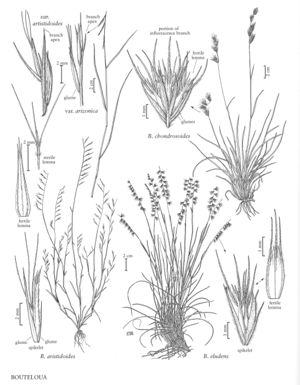Difference between revisions of "Bouteloua aristidoides"
FNA>Volume Importer |
imported>Volume Importer |
||
| (8 intermediate revisions by 2 users not shown) | |||
| Line 39: | Line 39: | ||
-->{{#Taxon: | -->{{#Taxon: | ||
name=Bouteloua aristidoides | name=Bouteloua aristidoides | ||
| − | |||
|authority=(Kunth) Griseb. | |authority=(Kunth) Griseb. | ||
|rank=species | |rank=species | ||
| Line 46: | Line 45: | ||
|basionyms= | |basionyms= | ||
|family=Poaceae | |family=Poaceae | ||
| + | |illustrator=Linda A. Vorobik;Cindy Roché | ||
| + | |illustration copyright=Utah State University | ||
|distribution=Md.;N.Mex.;Tex.;Utah;Calif.;Ariz.;Nev. | |distribution=Md.;N.Mex.;Tex.;Utah;Calif.;Ariz.;Nev. | ||
|reference=None | |reference=None | ||
| Line 51: | Line 52: | ||
|publication year= | |publication year= | ||
|special status= | |special status= | ||
| − | |source xml=https:// | + | |source xml=https://bitbucket.org/aafc-mbb/fna-data-curation/src/200273ad09963decb8fc72550212de541d86569d/coarse_grained_fna_xml/V25/V25_873.xml |
|subfamily=Poaceae subfam. Chloridoideae | |subfamily=Poaceae subfam. Chloridoideae | ||
|tribe=Poaceae tribe Cynodonteae | |tribe=Poaceae tribe Cynodonteae | ||
Latest revision as of 17:59, 11 May 2021
Plants annual; tufted. Culms 4-60 cm, outer culms of a tuft decumbent, sometimes geniculate, branched at the lower nodes. Ligules 0.2-0.5 mm, membranous, lacerate or ciliate; blades 2-5(9) cm long, 0.7-2 mm wide, flat or folded, adaxial surfaces sometimes with papillose-based hairs, margins usually with papillose-based hairs near the ligules. Panicles 2.5-10.5 cm, with (1)4-15 branches; branches 5-45 mm, deciduous, densely pubescent (at least basally), with 2-10 spikelets per branch, axes extending 2-10 mm beyond the base of the terminal spikelets, apices entire; disarticulation at the base of the branches, the break forming a sharp tip. Spikelets appressed. Proximal spikelet on each branch with 1 floret; lower glumes 1.5-3.5 mm, glabrous, narrow to subulate; upper glumes 5.5-6.2 mm, densely pubescent, at least on the basal 1/2; lemmas 5.8-6 mm, acuminate, unawned; lowest paleas almost as long as the lemmas, bifid, glabrous; rachillas prolonged beyond the florets for about 0.5 mm. Distal spikelets with 1 bisexual and 1 rudimentary floret, glumes unequal, glabrous, minutely scabrous on the keels; narrowly acute or acuminate; lower glumes 1.5-2 mm; upper glumes 5-6 mm, glabrous or sparsely pubescent basally, often divergent; lowest lemmas 6-8 mm, veins pubescent, lateral veins excurrent as short (to 1 mm) awns, acuminate, midvein extended into a setaceous tip or a short awn; lowest paleas 5-7 mm, bifid, veins often excurrent as short awns; anthers about 2.5 mm, yellow or yellow and red; distal florets reduced to a pubescent, 3-awned, awn column, awns 2-7 mm, exserted. Caryopses 2.5-3 mm. 2n = 40.
Distribution
Md., N.Mex., Tex., Utah, Calif., Ariz., Nev.
Discussion
There are two varieties, both of which grow in the Flora region.
Selected References
None.
Key
| 1 | Panicle branches with 2-5 spikelets, usually 5-16 mm to the base of the terminal spikelets, axes usually extending an additional 6-10 mm | Bouteloua aristidoides var. aristidoides |
| 1 | Panicle branches with 6-10 spikelets, usually 15-35 mm to the base of the terminal spikelets, axes extending an additional 2-5(7) mm | Bouteloua aristidoides var. arizonica |
